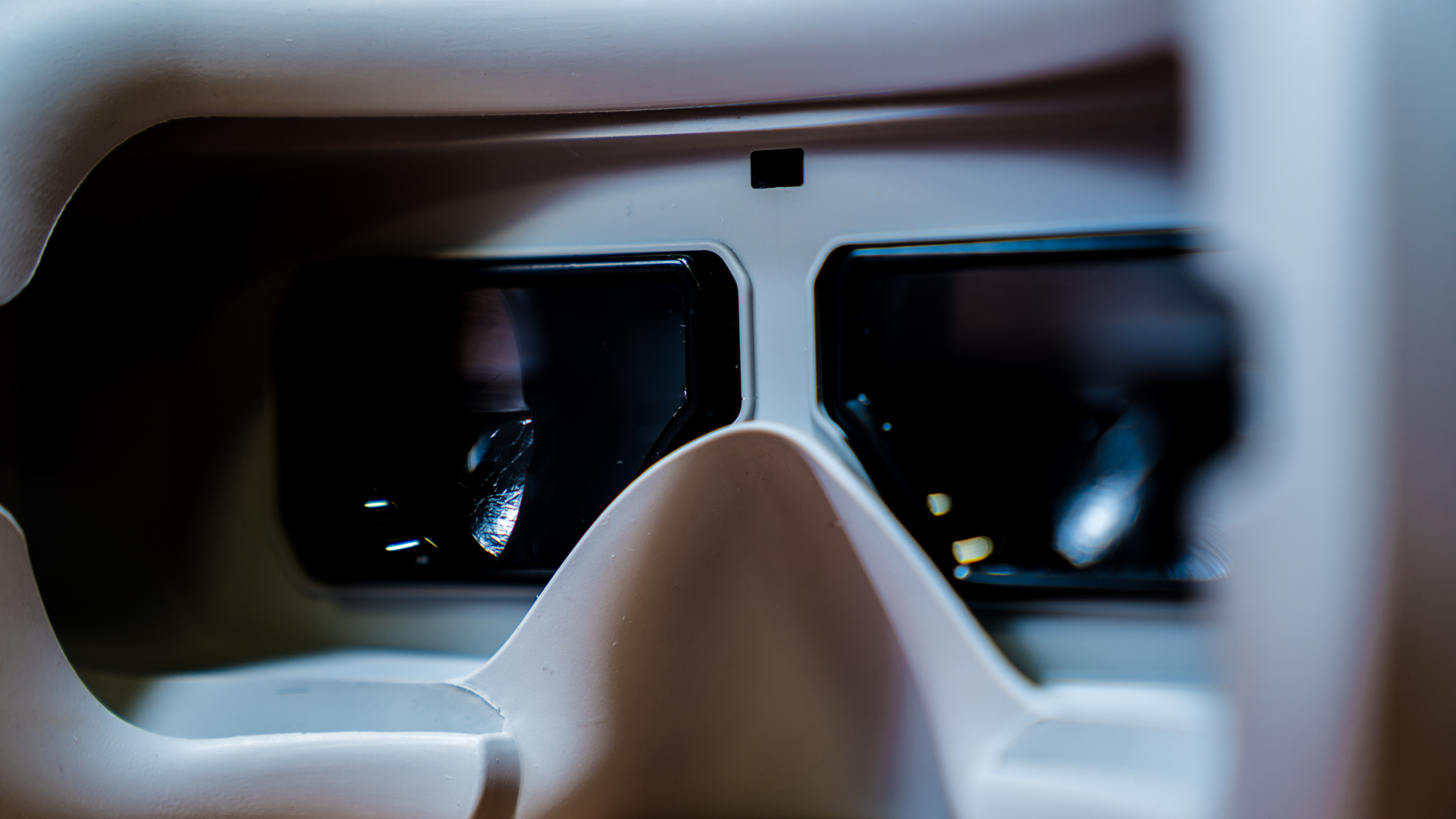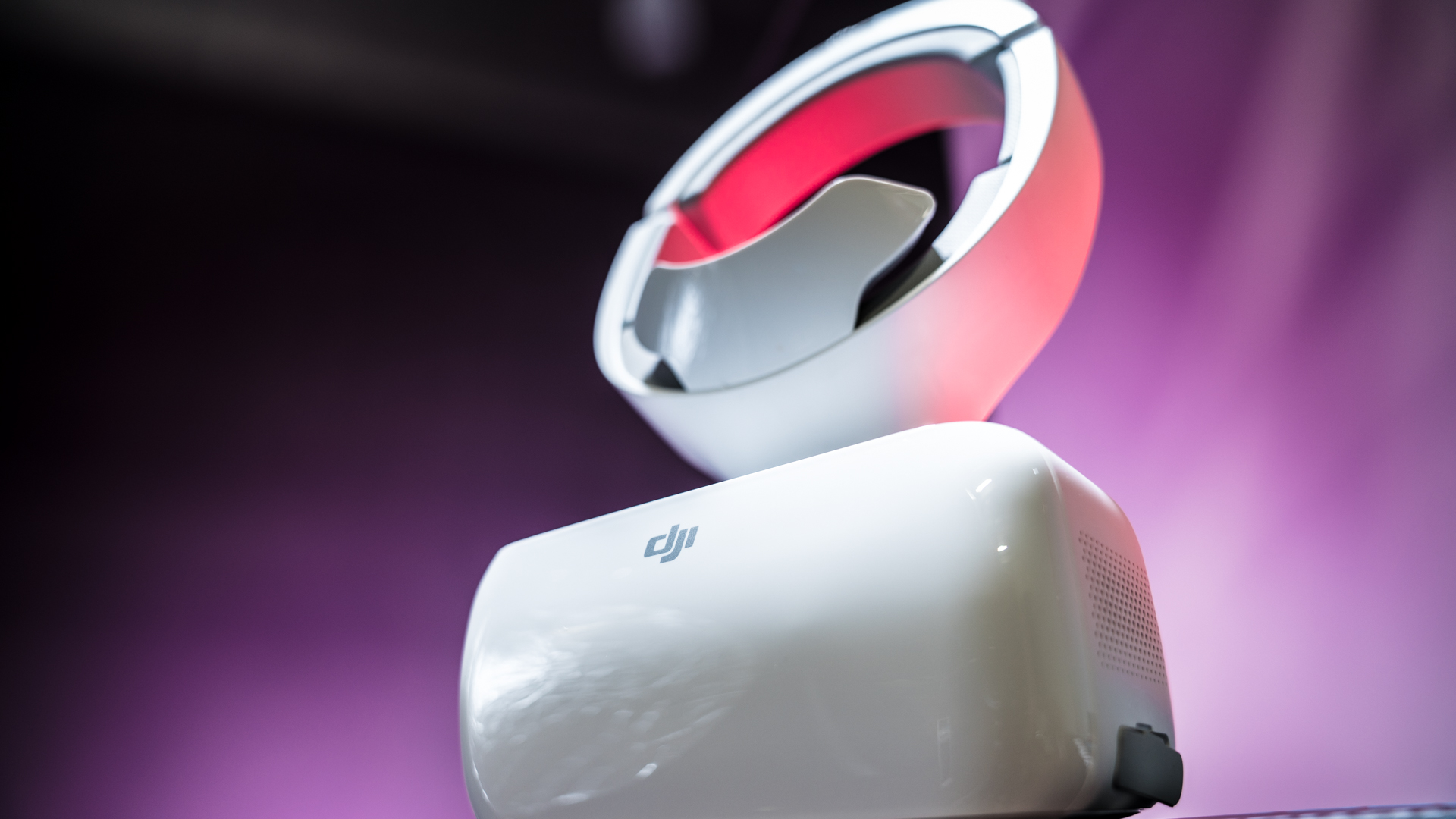
 The drone masters at DJI just came out with their latest creation, and it is pure brilliance. No, this isn’t the highly-anticipated drone launch rumored for later this month, but an appetizer to tantalize the senses. I’m of course talking about the DJI Goggles, which are a first from the company that constantly redefines the drone industry with their technology and quality.
The drone masters at DJI just came out with their latest creation, and it is pure brilliance. No, this isn’t the highly-anticipated drone launch rumored for later this month, but an appetizer to tantalize the senses. I’m of course talking about the DJI Goggles, which are a first from the company that constantly redefines the drone industry with their technology and quality.
Back in November I covered the Phantom 4 Pro & Inspire 2 announcement at a DJI press event in the Warner Bros. backlots, and caught a glimpse of this incredible piece of tech on display. Sleek and mysterious, there weren’t many details available, but the recent launch landed a pair in my lap to put through the paces with their Mavic Pro drone, and I experienced FPV (first-person view) flight on a new level.
Goggle design
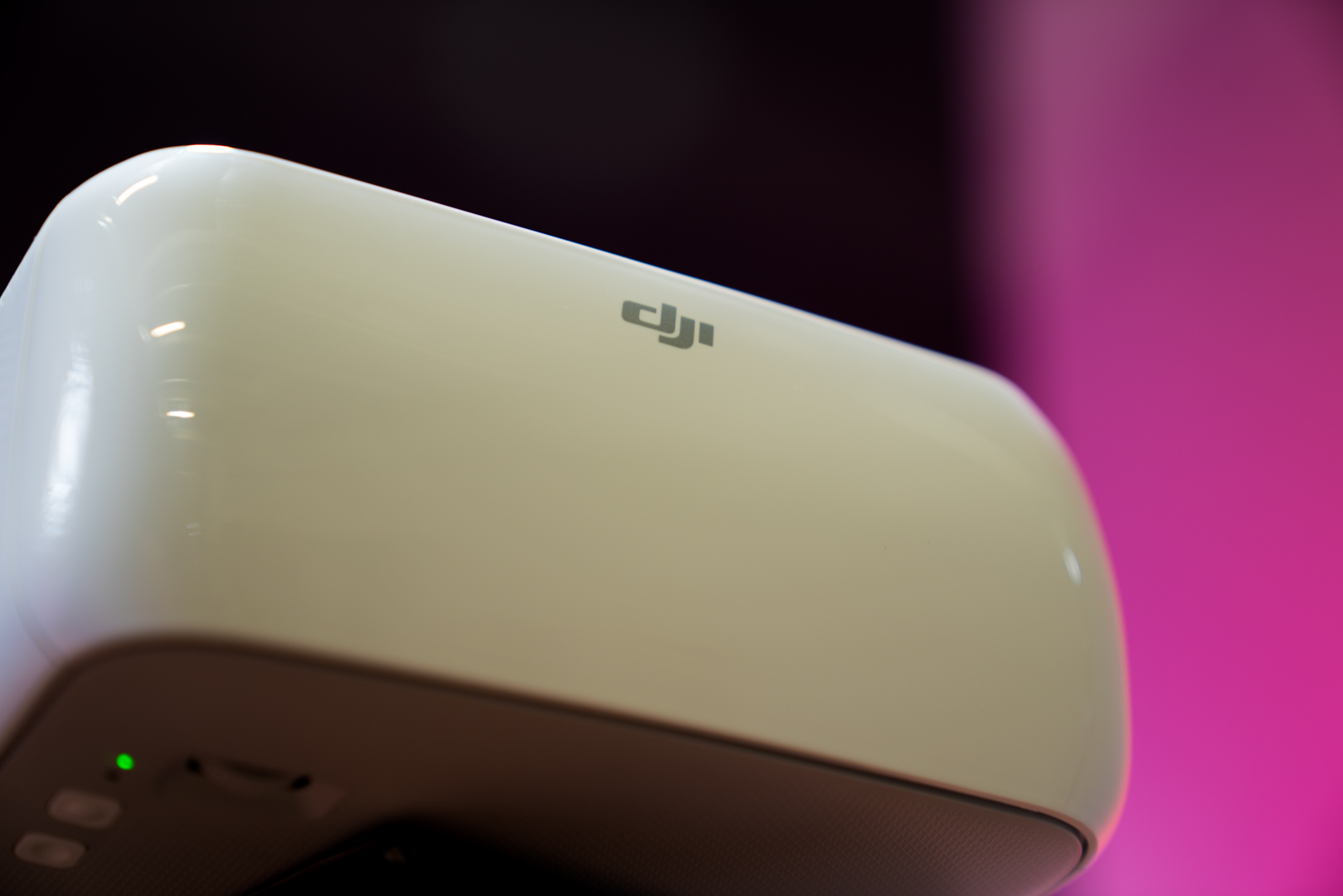
The signature DJI white plastic covers the smooth front of the goggles and headband, while the bottom has a triangular textured pattern in a grey tone that matches the padding around the inside of the headband. The underside of the goggles house the Interpupillary Distance (IPD) knob to adjust the spacing between left and right lenses, as well as function and back navigation buttons and two status LEDs. On the left side of the goggles you have a speaker, heat vent, and media ports.
The goggles have a MicroSD slot, 3.5mm headphone jack, and a Micro HDMI port for connecting to other media sources like a laptop or earlier model DJI controller.
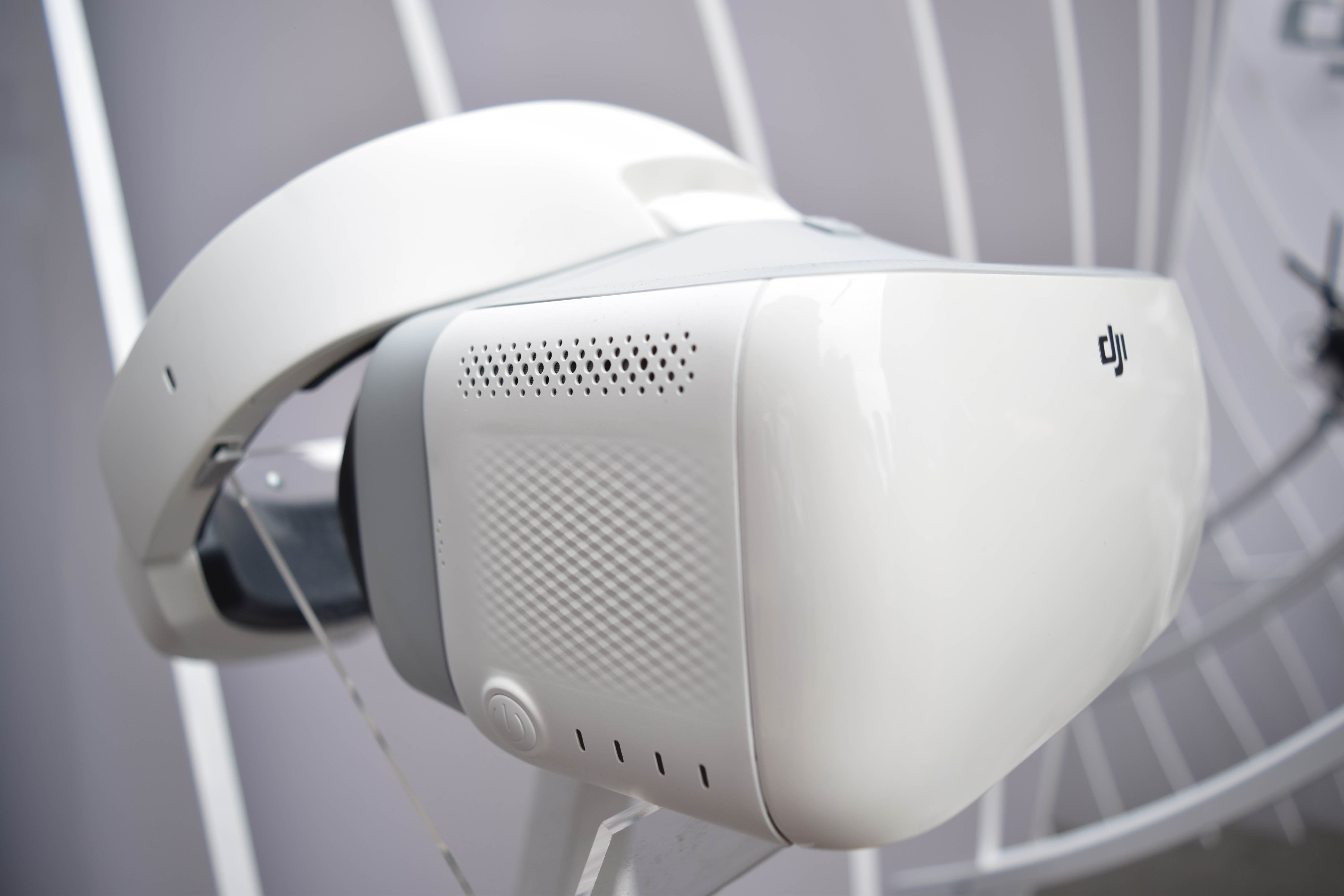 The construction quality is solid, not overly heavy but with enough heft to feel substantial. The semi-firm rubberized foam cushion padding that surrounds the headband and forehead brace feels comfy on the head, and a cinching band tightens the whole thing into place. The headband adjusts via a clicking knob on the back, and uses internal flat metal bands to keep the form and strength.
The construction quality is solid, not overly heavy but with enough heft to feel substantial. The semi-firm rubberized foam cushion padding that surrounds the headband and forehead brace feels comfy on the head, and a cinching band tightens the whole thing into place. The headband adjusts via a clicking knob on the back, and uses internal flat metal bands to keep the form and strength.
The materials seem well-suited for use outdoors where you would be flying a drone, and the rubber face mask around the edges (while not offering much support) is well-suited to be popped-off and wiped down to clean away sweat and dirt.
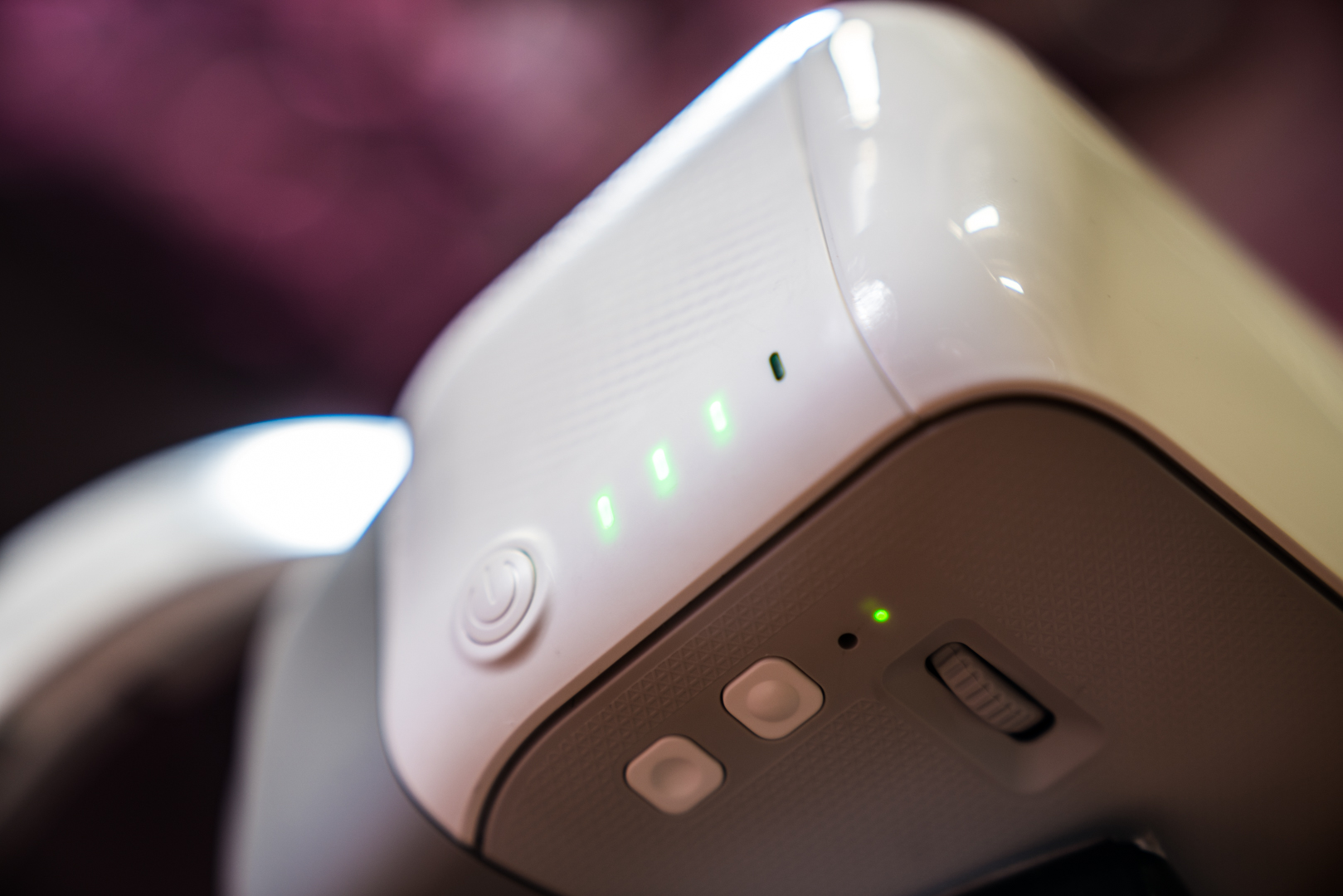 The right side of the goggles is where things start to get interesting. Here you find a two-inch square textured patch that acts as a touchpad for controlling navigation and settings within the DJI interface (it’s similar to the touchpad controls on the Samsung Gear VR).
The right side of the goggles is where things start to get interesting. Here you find a two-inch square textured patch that acts as a touchpad for controlling navigation and settings within the DJI interface (it’s similar to the touchpad controls on the Samsung Gear VR).
Using your fingers, you can swipe in different directions to access menus, take pictures, record video, and more. Using a dual-finger swipe you can access different menu options, or even lock the touchpad so it doesn’t get bumped accidentally.
Form and function
A very practical feature the goggles employ is having the unit flip up on the headband away from your face, so you can pull them up to get your eyes on real life without disrupting the unit positioning. As most drone pilots use a combination of line of sight and camera feed FPV to safely navigate the skies, this is very useful in the field when trying to locate the drone.
The distance between the lenses and the face mask allow for glasses to be worn, and after a solid 25 minutes of flight time the goggles didn’t leave me with any neck fatigue, as front-heavy as they do first appear.
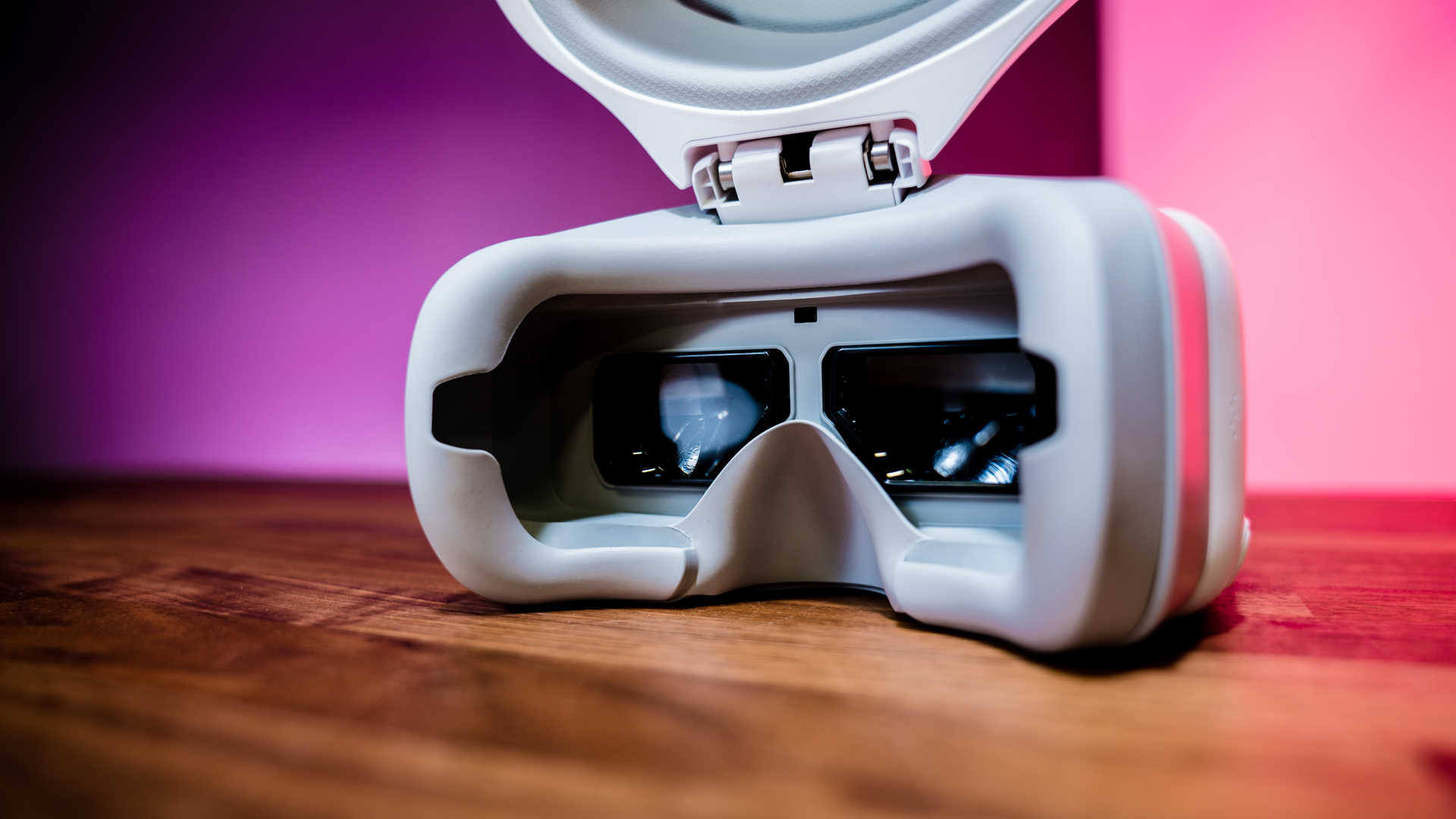 The battery life of the goggles is about six hours, which is longer than you will be likely to need them for several days’ worth of flight.
The battery life of the goggles is about six hours, which is longer than you will be likely to need them for several days’ worth of flight.
Between the eyes a small proximity sensor is nested, which is designed to detect when the goggles are pulled up away from the face and go into a sleep mode, to conserve battery life.
Image quality
Design is great, but what about the visuals?
These goggles are packing dual 1920x1080p screens that blend seamlessly to produce an immersive, crisp picture that delivers a next-level FPV experience. That 1080 resolution live view comes through at 30fps in “HD Mode” at shorter distances with limited interference, and automatically switches to 720p “Smooth Mode” with 60fps. I found that even at the 720p resolution the quality wasn’t bad and did indeed live up to the “smooth” name, but the 1080p was the more incredible experience.
The transmission distance of the goggles is the same as the controller itself (4.3 miles) and operates at 2.4GHz, so you don’t have to worry about losing picture mid-flight and getting lost. The goggles have a 60Hz refresh rate and 110ms latency, and during my flights I haven’t noticed any banding, lag, or any artifacts in the live view.
The goggles use a beam splitter to display one single image for each eye, in addition to polarization technology to prevent image overlap. This helps to deliver a widescreen, full 1080p per eye without any fisheye distortion at 85° field of view, assisted by the aspheric lenses.
DJI Go, without the phone
The visual display acts just as your standard DJI Go interface does, and projects all the same information directly in your line of sight. You get access to flight telemetry and all the attitude settings (directionality, roll, tilt angle, and yaw) that are important to pay attention to. I found that this makes flight much more intuitive; instead of craning my neck down to peep at a small screen I have a full screen view of all the data.
Another added bonus of this display method is that the bright glare from the sun no longer obstructs visibility of the screen, and my phone battery remains untouched. The onboard DJI OccuSync software allows you to connect up to 2 goggles to the Mavic Pro, which means you could potentially have someone bear witness to your aerial FPV via a Multiuser Mode and Coach Mode.
Since these goggles aren’t throwaways at $449 getting two might be unlikely, but if you felt the need you could take advantage of it.
More on that touchpad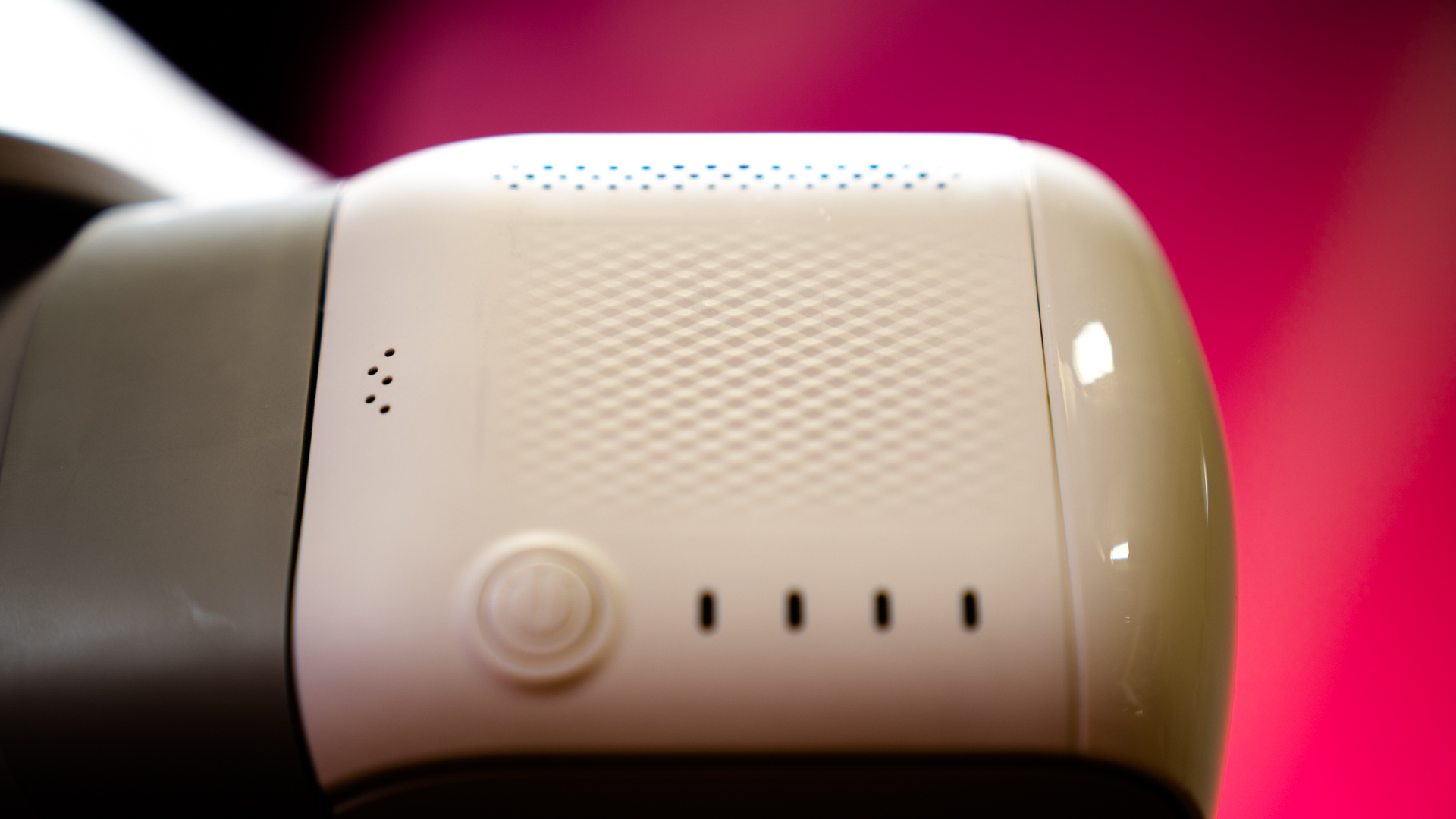
In use the touchpad functioned seamlessly to navigate through flight modes, adjust camera settings, start and stop recording, control playback, and even initiate the takeoff function. From the home screen you can swipe left or right to access photo/video recording or camera settings.
Photo modes include HDR, single shot, multi-shot, timed shot and bracketing as well as video recording. The photo settings for aperture, shutter speed, ISO, exposure, white balance, and color are all adjustable in-flight via a few short finger strokes.
One of the really neat perks besides seeing the live video feed and controlling the settings is accessing the video footage playback remotely. What this means is that you can capture video and photos, then switch over and review them while still in flight, all without ever touching down. Since the footage review is coming through at 1080p, you get a pretty good idea of how the final 4K footage from the drone would appear, as sometimes the live view will be in 720p.
The MicroSD card slot onboard the goggles can be used to replay footage, and while it would be awesome to have the ability to record the in-flight view with all your flight telemetry, this isn’t possible just yet.
Pre-Order DJI Goggles $449
Drone compatibility
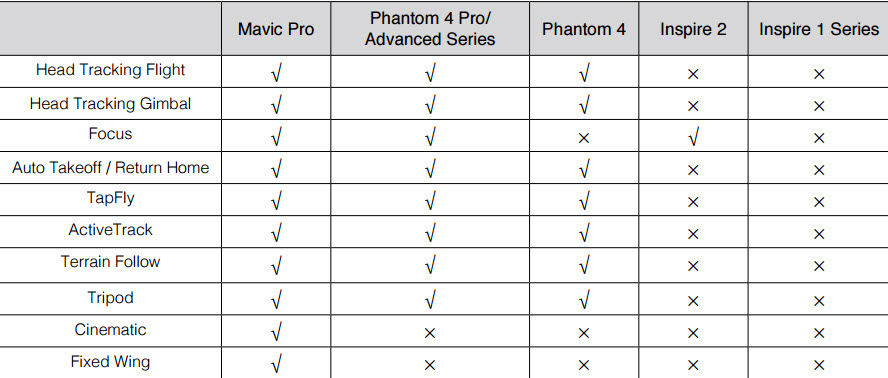
While this new creation is clearly designed with the Mavic Pro in mind, DJI did throw a bone to their other drone owners by extending the compatibility to the Phantom 4 series (Phantom 4, Phantom 4 Pro, and Phantom 4 Advanced) as well as the Inspire 2. The functionality with these models varies, but the one constant is the need for a wired connection between the goggles and the controller. Not a big deal, but access to the nifty features of the goggles does skew more heavily to some models over others, which means pre-Mavic owners might be feeling a twinge of jealousy.
Head in the game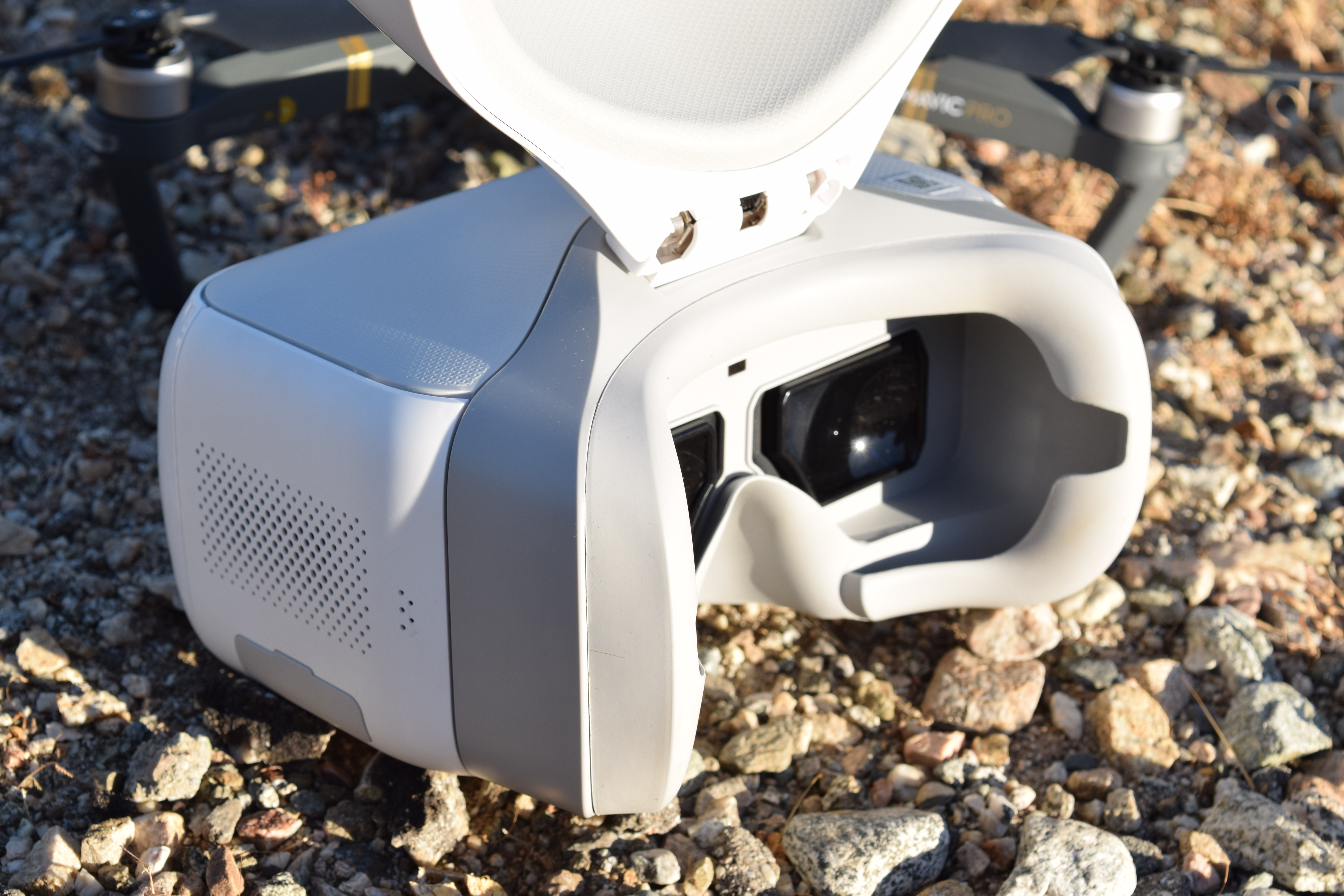
While we aren’t quite to the point of controlling drones with our minds, DJI is taking aim at getting us darn close to it with these goggles. They’ve taken a VR approach to the project, and created something that delivers a completely new experience, and they’ve done it right. While all the functions I’ve mentioned are cool there is one that stands above the rest in my book: head tracking.
Head tracking is a technology that converts the motion of your head—via the goggles—into another, disconnected action. In this instance, slapping the goggles on my face and swiping my way into the head tracking modes allows me to direct the movement of the gimbal with nothing more than a turn of my head.
In “Motion-controlled Flight” mode, turning your head left or right pivots the actual aircraft left or right (yaw) 360°, while head motion up or down controls the vertical pitch (-90° to 30°). A similar mode is “Motion-controlled Gimbal”, which enables multi-directional articulation of only the gimbal itself, while the aircraft remains untouched by head movement. This gives a pilot yaw control (-30° to 30°), and again delivering a pitch range of motion from -90° to 30°.
The big “wow” moment came for me while I was doing this, thinking about any other DJI drone I’ve flown (Mavic Pro included), and realized that gimbal control was limited to vertical pitch. The goggles opened up a whole new functionality of the current hardware, and gave a new dimensionality to previous hardware. I have had a blast showing this off to anyone who will listen, and love demoing the camera as it mimics my movement like a little ventriloquist robot. The ability to capture butter-smooth pan shots even diagonally with a fluid motion and simple input is astounding, and should be appreciated by anyone interested in shooting video.
Intelligent flight support
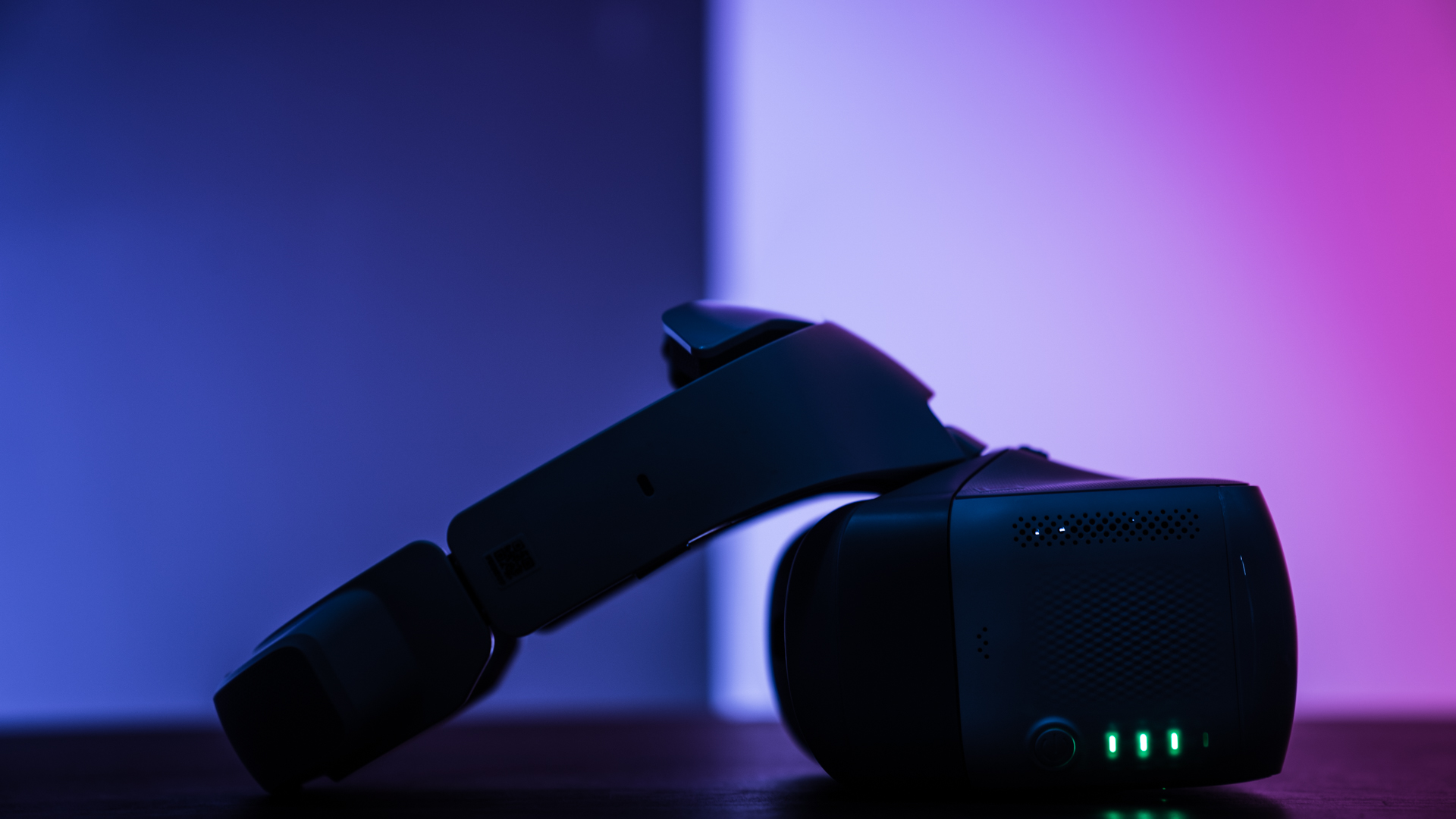
One of DJI’s trademark characteristics is their intelligent flight modes, which range from Terrain Follow to circular flight patterns around an object, and many more. The new goggles support several intelligent flight modes (beyond the one-tap Takeoff and Return to Home), with two jumping out at me as inventive adaptations.
Tap Fly is a great feature that gives you one-tap command of the drone to direct it into an area that appears on the screen. When you select this mode with the headset, you have a cursor that appears on the screen. To choose the location you want to fly towards, you just move your head around, align the cursor, and tap once on the touchpad to send the drone off to your waypoint.
With Active Track, you have the ability to send the drone off to follow an object in motion. Similar to using the screen of your mobile device with previous DJI drones, you just enable the mode via the touchpad, and drag a little box around the subject you wish to follow that is in your field of view. The only difference is this is all done on the track pad on the goggles, instead of on the image appearing on the DJI Go app. This feels a little foreign at first, something akin to attempting a task with your less dominant hand.
DJI Goggles – final verdict 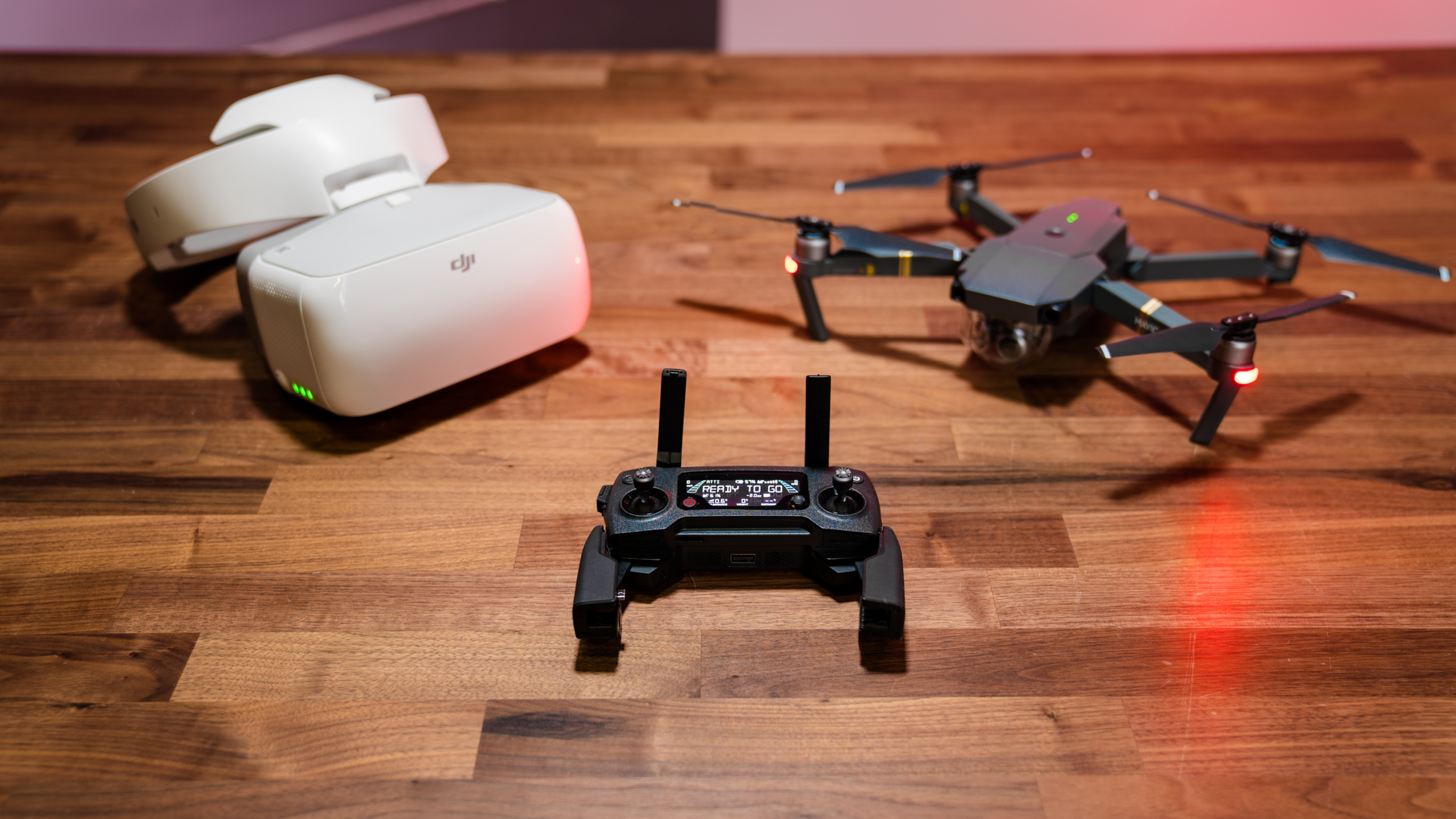
With so many VR headsets on the scene today, I’ve seen a variety of head-mounted designs. While some of them are clear winners, so many more fail miserably. The main issue with many headsets is that they don’t have a specific purpose, and if they do it isn’t served properly with enough quality design. Fortunately, the DJI Goggles don’t have this problem at all.
These goggles were meticulously designed, crafted, and executed in a way that makes them perfect for what they are intended to do (with a little extra in the entertainment department). My editor has more experience with everything VR than most, and has probably tried out more headsets than anyone. He commented that while he would like to see a support strap connecting the front and back of the headset to help reduce the contact on the bridge of his nose, he completely dug the attention to detail that went into the creation of the headset for drone flight, and found it was executed impressively.
This latest launch from DJI adds some diversity to their rich portfolio of products, and for their first go at a headset this is a home run. It was practical, smooth to operate, and the details were planned out with actual drone flight in mind.
With the upcoming announcement later this month, May is shaping up to be a very exciting month for drone fans, and you can pre order the DJI Goggles on Newegg now for $449.

